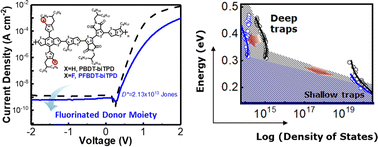Low dark current density in organic photodiodes achieved by reduced trap states of conjugated polymers bearing a fluorinated moiety†
Abstract
A low dark current density (Jd) is critical for enhancing the performance of organic photodiodes (OPDs), and is evaluated using device parameters such as the signal-to-noise ratio, specific detectivity (D*), and linear dynamic range. However, the design rules for conjugated polymers to reduce the Jd in OPDs are rarely accessible. In this study, we present a strategy to obtain low Jd values in OPDs from a material point of view, by investigating the optoelectric properties of OPDs based on donor–acceptor (D–A) type conjugated copolymers. To this end, two D–A type copolymers were prepared with thieno[3,4-c]pyrrole-4,6(5H)-dione (TPD) as a common electron-withdrawing unit and 4,8-di(thiophen-2-yl)benzo[1,2-b:4,5-b′]dithiophene (BDT) or fluorinated BDT (FBDT) as an electron-donating unit. We then examined OPDs with an active layer formed by blending the fullerene derivative [6,6]-phenyl C71 butyric acid methyl ester (PC71BM) and the newly synthesized D–A type copolymers (PBDT-biTPD and PFBDT-biTPD). Under a reverse bias of −2 V, a low Jd of 6.09 × 10−10 A cm−2 was observed for the PFBDT-biTPD-based OPD, which showed a maximum responsivity of R = 0.30 A W−1 and D* = 2.13 × 1013 Jones at 500–650 nm, while the PBDT-biTPD-based OPD possessed a relatively higher Jd (1.43 × 10−9 A cm−2). Systematic analyses based on structural characterization of these active thin-film layers and the sub-gap density of states (DOS) measured using the OPDs and organic field-effect transistors revealed that fluorination of the electron donor unit in a D–A type conjugated polymer is an effective way to reduce the Jd of OPDs by suppressing the trap DOS in the blended active layer.

- This article is part of the themed collection: Journal of Materials Chemistry C HOT Papers


 Please wait while we load your content...
Please wait while we load your content...